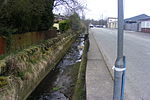Hawk Mill, Shaw
1908 establishments in England1991 disestablishments in EnglandBuildings and structures completed in 1908Buildings and structures demolished in 1991Demolished buildings and structures in Greater Manchester ... and 5 more
Demolished manufacturing buildings and structuresFormer textile mills in the United KingdomShaw and CromptonTextile mills in the Metropolitan Borough of OldhamTextile mills owned by the Lancashire Cotton Corporation
Hawk Mill, Shaw was a cotton spinning mill in Shaw, Oldham, Greater Manchester. It was built in 1908. It was taken over by the Lancashire Cotton Corporation in the 1931 and passed to Courtaulds in 1964. The mill closed in 1967, and was demolished in 1991.
Excerpt from the Wikipedia article Hawk Mill, Shaw (License: CC BY-SA 3.0, Authors).Hawk Mill, Shaw
Hawksmoor Drive,
Geographical coordinates (GPS) Address Nearby Places Show on map
Geographical coordinates (GPS)
| Latitude | Longitude |
|---|---|
| N 53.5831 ° | E -2.0924 ° |
Address
Hawksmoor Drive
Hawksmoor Drive
OL2 7UW , Wood End
England, United Kingdom
Open on Google Maps








